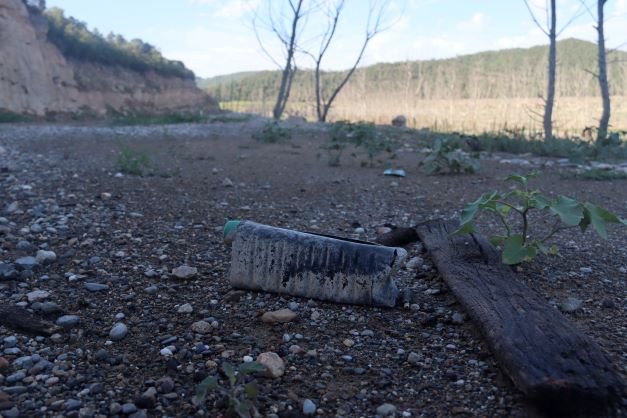Intense heat and little rainfall intensify drought in Catalonia
Barcelona weather station recorded average summer temperature 4.4°C higher than mid-20th century mean

During the current spell of drought that Catalonia is undergoing, the famous sunken church at the bottom of the Sau reservoir has become visible in its entirety, as well as a nearby historic cemetery for the first time in many years.
Drought is officially declared in Catalonia when the total combined water reserves in reservoirs fall below 40%. As of September 16, 2022, the level was recorded at 37%.
From May to September of this year, water reserves in the Sau reservoir have fallen by 51%. Last summer, the reservoir was almost at full capacity, but now it’s only 29% full. This situation has arrived because of prolonged periods of intense heat coupled with little rainfall over the past year. The alarm was first raised last spring, when, after one of the driest winters in 50 years, reservoir levels fell to only around half full.
Hot summer, dry winter, irregular rain patterns
Catalonia has suffered one of the hottest summers on record in most of the territory in 2022. In the Barcelona weather station, which has data stretching back to 1905, the second hottest summer ever was registered, with an average temperature of 26.2°C. This is 4.4°C hotter than the average between 1961-1990.
All parts of the territory saw temperatures between 2.5-5.5°C hotter than summer averages, and most saw record high levels of heat, surpassing records set in a particularly hot summer in 2003.
August also saw very irregular rain patterns. The territory had some periods of heavy rain and thunderstorms but overall it was very dry.
Additionally, last winter was the driest in 50 years, with many parts of the country only getting about 20% of its average rainfall for that time of year. These factors have combined into a disastrous set of conditions for water reserves and agriculture.
Restrictions on water use
Restrictions on water use were introduced this summer in hundreds of towns, including reductions in the use of water for agriculture, industrial use, and recreational use, and the threat of further restrictions looms, potentially even for personal use, as the drought worsens.
Such actions are determined by a traffic light protocol that Catalan authorities have in place, determining what to do in the event of water levels dipping below a certain threshold. Unlike street traffic lights, this one has five colours: blue, green, yellow, orange, and red. At the moment, there have been no restrictions on domestic use of water, but if things get worse, this could change.
The traffic light system that Catalonia uses for reservoirs and water use is as follows:
Blue - All normal.
Green - Pre-alert stage, when reservoirs are below 60% full. Authorities monitor water reserves more closely and information campaigns may be published.
Yellow - Alert stage, when reservoirs are below 40% full. The first set of restrictions are brought in, water is distributed in accordance with priority, and the production of non-conventional resources such as aquifers and other underground extractions increases.
Orange - Exceptional state, when reservoir levels are below 25% full. Further reductions in non-priority use of water. Extraction of water from unconventional and underground resources are fully activated. Certain uses are prohibited in urban areas. Allocations reduced for things like agricultural use, recreational use, industrial use. Forbidden to clean streets, sewers, pavements, and buildings with drinking water. A maximum allocation of 230 liters per inhabitant per day is established.
Red - Emergency, when reservoirs are below 16% full. Restrictions in all uses, distribution controlled, but human use is the top priority. A maximum of 200 litres of water per person per day is established, and this can be lowered if necessary.
Less water, less hydroelectric power
Less water in reservoirs also means less hydroelectric power, which accounts for 60% of the renewable energy produced in Catalonia, and 12% of the overall energy.
Across the territory, production fell by nearly 15% between January and July 2022 compared with the same period the year before. Compared with average production in the same months over the past ten years, 2022’s production is almost 35% lower.


